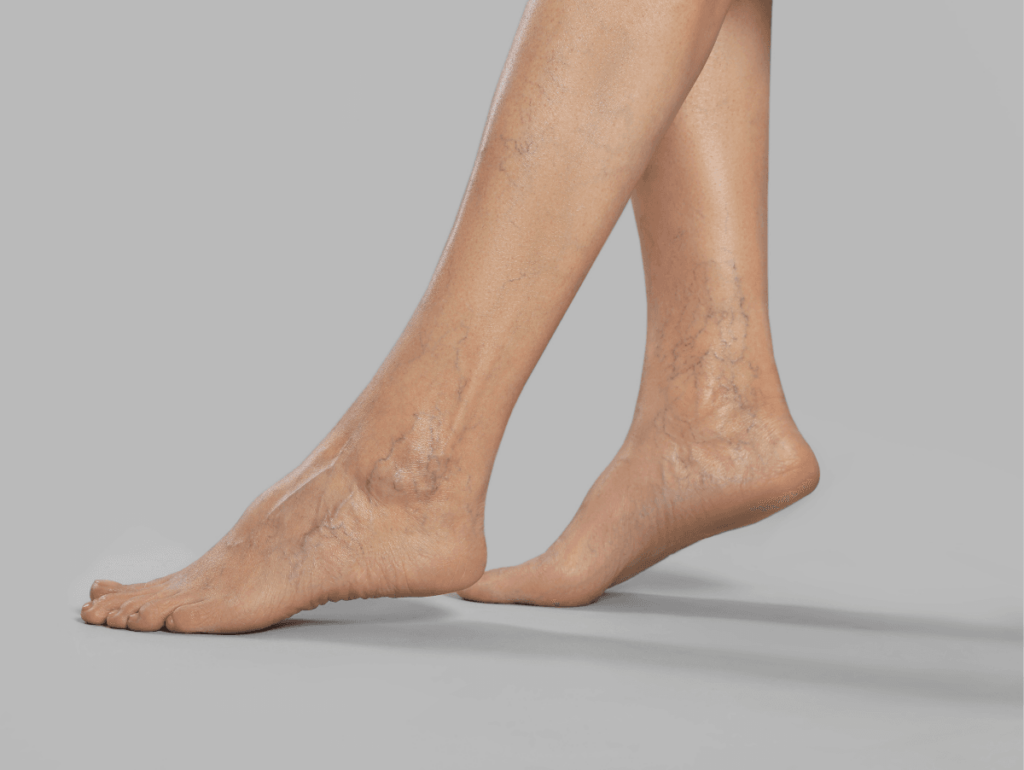
| Varicose veins not only affect your physical appearance but can significantly impact your ability and willingness to engage in regular exercise. Certain low-impact activities like walking, cycling, and swimming are favorable. While there is room to push yourself, caution is needed when engaging in high-impact exercises.
Embracing a proactive approach to varicose vein care, including consulting with healthcare professionals and vein specialists, can ensure a balanced and active lifestyle. If you’re wondering how you can stay fit while dealing with varicose veins, schedule a consultation with Advanced Vein & Laser Centre today for personalized guidance and treatment solutions. |
Varicose veins are about more than just how they make your legs look; they can have a significant impact on how you move, especially during exercise. Engaging in the wrong type of exercise while coping with varicose veins might exacerbate symptoms, causing increased discomfort and potentially limiting your range of motion or leading to injuries.
Understanding the intricate relationship between varicose veins and exercise is crucial for making informed choices that will preserve both your vascular health and overall well-being.
In this guide, we’ll dive deep into varicose veins, understanding why they happen, what signals they give, and how they affect our physical activities. Let’s simplify the complex relationship between varicose veins and exercise to see how they will impact your physical fitness.
Understanding Varicose Veins: The Basics
Varicose veins are those twisted and swollen veins that sometimes develop on the legs. They’re caused by the weakening of the valves within the leg veins that are responsible for ensuring a one-way flow of blood back to the heart. These valves are essentially like little gates within the veins that prevent blood from flowing backward.
However, when these valves become weak and aren’t functioning properly, the blood begins to pool within the veins, causing the visible swelling that we know as varicose veins. Varicose veins are often blue or dark purple and can cause bruising and damage to the skin.
While they aren’t limited by age or weight, certain factors such as genetics, gender, and specific occupations that involve prolonged standing or sitting, may increase susceptibility.
What Causes Varicose Veins?
Varicose veins are not a simple occurrence, but are instead, a result of a complex interplay of factors contributing to their development. This intricate web of causes includes everything from genetic predispositions to lifestyle choices.
Understanding the various causes and risk factors for the development of varicose veins provides important insight into dealing with the condition as well as how it can impact the various aspects of your life, particularly, how and if you exercise.
- Genetics: A familial history of varicose veins increases the likelihood that you might develop the condition yourself. The hereditary influence often results in weakened vein walls or malfunctioning valves, creating a predisposition to varicose veins.
- Aging: The aging process causes wear and tear on veins, diminishing their natural elasticity and increasing susceptibility to dysfunction. As you age, the risk that you may develop varicose veins naturally increases.
- Gender Differences: Women face an elevated likelihood of developing varicose veins, particularly during periods of hormonal fluctuations such as pregnancy and menopause. The hormonal shifts and increased pressure on the veins contribute significantly to the development of varicose veins in women.
- Work Factors: If you have an occupation that involves prolonged periods of standing or sitting such as nursing and teaching contribute to the chances that you may develop varicose veins. These work-related conditions can impede blood circulation and heighten your risk of varicose veins.
What Are The Signs & Symptoms Of Varicose Veins?
Varicose veins often announce their presence through a range of discomforting symptoms like aching, throbbing, or noticeable swelling. While these signs might seem benign, they are crucial signals from your body that should prompt you to seek professional advice from a medical professional or vein specialist as soon as possible.
Left untreated, varicose veins may not only compromise your quality of life by causing discomfort but also pose a risk of leading to more severe health issues in the long run. Some of the most common signs and symptoms of varicose veins are:
Aching or Pain:
Aching or pain associated with varicose veins ranges from subtle discomfort to a pronounced throbbing feeling. This discomfort can vary in intensity but is a common indicator of compromised vein health.
Swelling
Leg swelling is another signal that you may be developing varicose veins. Especially when the swelling occurs after prolonged periods of standing. Swelling is a result of blood pooling in the affected veins, and it’s a visual cue that warrants immediate attention.
Visible Veins
Varicose veins manifest as twisted and bulging veins that become noticeable on the legs. The appearance of these veins can be unsettling, but understanding this visual aspect is crucial for identifying varicose veins early on.
Itching or Burning
Itching or burning sensations may accompany varicose veins, adding to the array of signals that something may be amiss. While not always present, these sensations can be disruptive, affecting your quality of life and certainly impacting how willing or able you are to exercise.
Can You Exercise If You Have Varicose Veins?
Varicose veins will have a big influence on both your willingness and ability to exercise. Anyone with varicose veins needs to do only workouts that are tailored for them to avoid doing exercise routines that will exacerbate the symptoms.
In understanding the complex relationship between varicose veins and exercise, and knowing how one affects the other, you can make informed choices that support your overall well-being.
- Discomfort During Exercise: The presence of varicose veins introduces a variable discomfort during exercise, with certain movements causing different levels of unease. This discomfort may range from mild sensations to more pronounced pain, making it all the more important to seek medical advice before committing to a workout plan.
- Less Flexibility: Varicose veins contribute to reduced flexibility, primarily due to accompanying swelling that limits the extent of stretching and movement. This limitation can hinder your overall range of motion during exercise and requires you to be mindful of your body’s response to different activities.
- Feeling Self-Conscious: The visibility of bulging veins can evoke self-consciousness, impacting the mental and emotional aspects of engaging in physical activities. You may become hesitant to exercise, particularly in settings where the appearance of your legs is more exposed. If that is the case, you may want to consider prompt treatment of your veins so your legs can look and feel healthy again.
Exercise and Varicose Veins: Picking the Right Moves
Engaging in the right kinds of exercises is important for anyone dealing with or recovering from varicose veins. Prioritizing low-impact activities can help you maintain your overall fitness levels without putting undue strain on your veins and worsening your varicose veins symptoms.
This cautious approach is particularly crucial post-treatment to ensure a smooth recovery and minimize the risk of complications. After treatment, it’s essential to gradually reintegrate physical activities into your routine, starting with gentle exercises that promote blood circulation without causing discomfort.
Consistent, mindful exercise can contribute not only to the prevention of varicose veins but also to the overall well-being of individuals navigating this common vascular condition.
Good Choices:
- Walking: An easy and effective activity that promotes blood flow without straining the legs. Regular walks not only enhance overall cardiovascular health but also contribute to maintaining optimal leg function.
- Cycling: A low-impact option that is gentle on the legs while providing a beneficial workout. Cycling helps improve muscle tone and circulation, supporting the management of varicose veins.
- Swimming: A full-body workout that avoids stressing the veins, offering a comprehensive exercise routine. Swimming engages multiple muscle groups without causing undue pressure on the circulatory system, making it an excellent choice for those with varicose veins.
Be Cautious with:
- High-Impact Activities: Activities like running may increase pressure on the veins, potentially intensifying your discomfort. Opting for lower-impact alternatives can reduce the strain on your veins and alleviate many symptoms associated with varicose veins.
- Lifting Heavy Weights: Straining during weightlifting can contribute to worsening varicose vein symptoms. Choosing lighter weights with higher repetitions and focusing on controlled movements can provide you with strength benefits without exacerbating vein-related issues.
Adding Exercise to Varicose Vein Care: A Simple Plan
Maintaining an active lifestyle remains pivotal, even when dealing with varicose veins. Exercise plays a crucial role in managing this condition, promoting blood circulation, and contributing to overall vascular health. However, it’s imperative to approach exercise with a thoughtful strategy, especially when you have varicose veins.
By taking a proactive and informed approach to exercise, you can strike a balance between staying physically active and managing varicose vein-related concerns effectively.
Talk to a Pro
Seeking professional guidance is essential for individuals with varicose veins. Consulting with a healthcare professional or a vein specialist ensures that your exercise routines will be tailored to your health conditions, minimizing potential risks and maximizing the benefits.
Gentle Cardio Activities
Incorporating gentle cardiovascular activities into your routine can significantly benefit individuals with varicose veins. Activities such as walking, cycling, or swimming promote blood circulation without exerting excessive pressure on the veins, fostering overall cardiovascular health while being mindful of vein-related concerns.
Leg Elevation and Stretching
Integrating leg elevation and regular stretching exercises is crucial for managing varicose veins. Elevating the legs helps reduce swelling and improve blood flow, while stretching exercises enhance flexibility, contributing to better vein function. This combination of practices supports overall vascular health and aids in minimizing the discomfort associated with varicose veins.
Is It Possible To Prevent Varicose Veins From Forming?
While varicose veins may not be entirely preventable, there are effective strategies to significantly reduce the likelihood of developing them. Implementing preventive measures is crucial for individuals seeking to proactively manage their vascular health.
This includes adopting lifestyle habits that promote healthy blood circulation and vein function. However, it’s important to note that the most suitable prevention techniques can vary based on individual factors.
Consulting with a vein specialist or healthcare professional is the best way to gain a clear understanding of the preventive measures that are best suited for you.
- Stay Active: Engaging in regular physical activity is vital for maintaining healthy veins. Exercise promotes optimal blood circulation, preventing blood from pooling in the veins and contributing to the overall well-being of the vascular system.
- Eat Well: Adopting a well-balanced diet rich in fiber and low in salt is beneficial for managing weight, a factor that can impact vein health. A healthy weight reduces the strain on veins and supports overall cardiovascular health, contributing to the prevention of varicose veins.
- Move Around: Avoiding prolonged periods of immobility is essential for individuals concerned about varicose veins. Regular movement, whether through short walks or changes in posture, prevents blood stagnation, reducing the risk of developing or exacerbating vein-related issues. Incorporating movement into your daily routine is a simple yet effective way to protect your vascular health.
How Are Varicose Veins Treated?
When varicose veins start affecting your ability or willingness to exercise, seeking professional advice becomes crucial. It’s important to consult with a specialist who understands your unique situation. During your consultation, the vascular expert will assess the severity of your varicose veins, discuss your symptoms, and understand your lifestyle.
Based on this evaluation, they can recommend personalized treatment options that align with your individual needs. It’s essential to speak to a vein specialist to explore the most effective and tailored solutions for managing varicose veins, allowing you to continue leading an active and healthy lifestyle.
Here are just a few of the treatments a specialist might recommend:
1. Compression Stockings
These specialized stockings apply graduated pressure on the legs (tightest at the ankle and loosening gradually the further up the leg they go. That pressure aids blood flow by preventing blood from pooling and reducing swelling. They are a non-invasive option that can be easily incorporated into daily routines for ongoing support.
2. Sclerotherapy
This procedure involves the injection of a solution directly into the affected veins, causing them to collapse and eventually fade from view. Sclerotherapy is a minimally invasive approach that is particularly effective for smaller varicose veins and spider veins.
3. Endovenous Laser Ablation (EVLA)
Using laser energy, EVLA closes off malfunctioning veins, redirecting blood flow to healthier vessels. This precise and minimally invasive treatment is suitable for larger varicose veins and offers a quicker recovery compared to traditional surgery.
Contact Advanced Vein & Laser Center Today To Discover Whether Varicose Veins And Exercise Co-Exist.
Varicose veins might affect how you exercise, but with some adjustments, they won’t take over the show. If you’re dealing with varicose veins and considering a new exercise routine, talk to the healthcare pros and vascular specialists at Advanced Vein And Laser Center.
Taking a proactive approach to your vascular health ensures a smooth and active lifestyle where you can feel comfortable in your skin.


